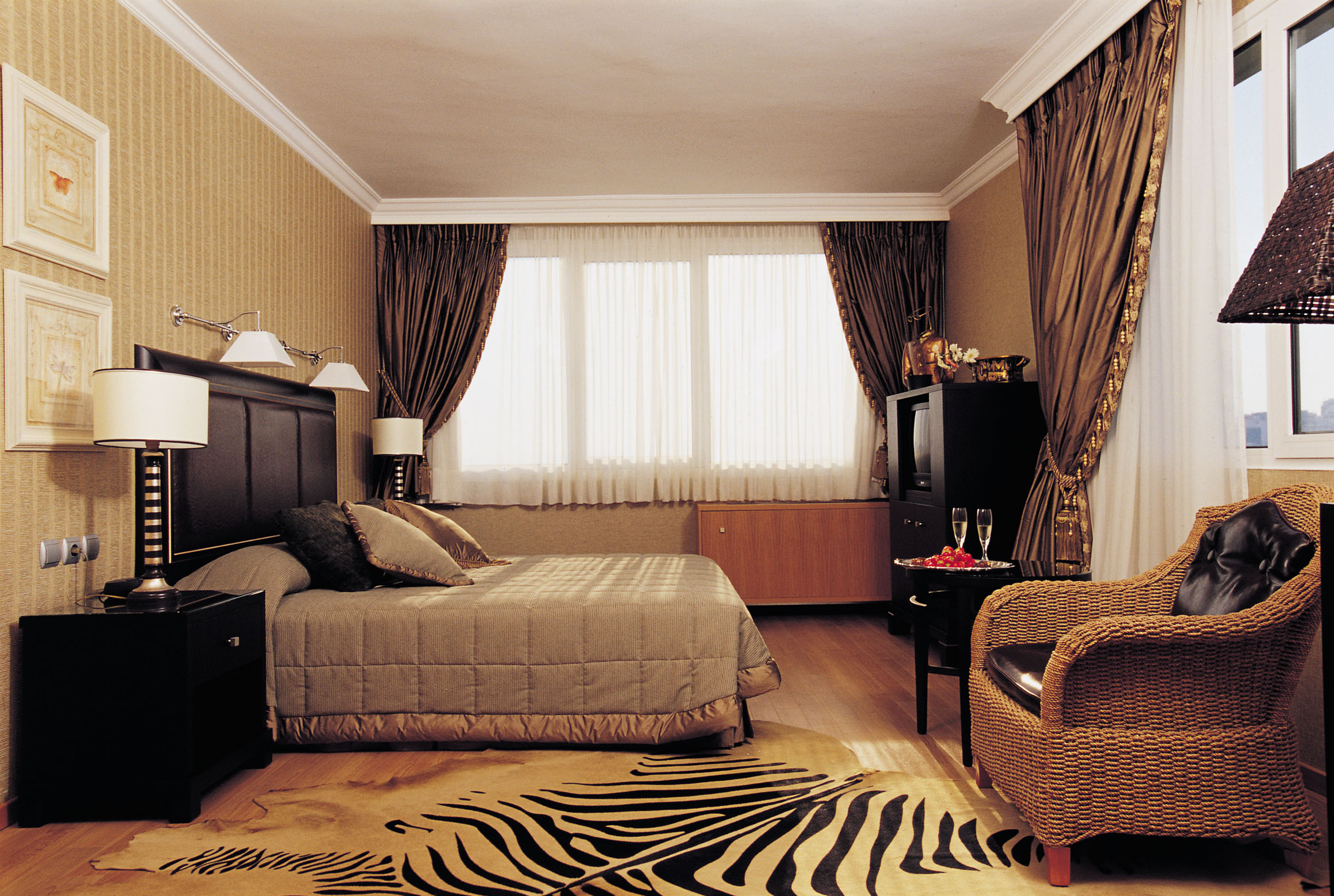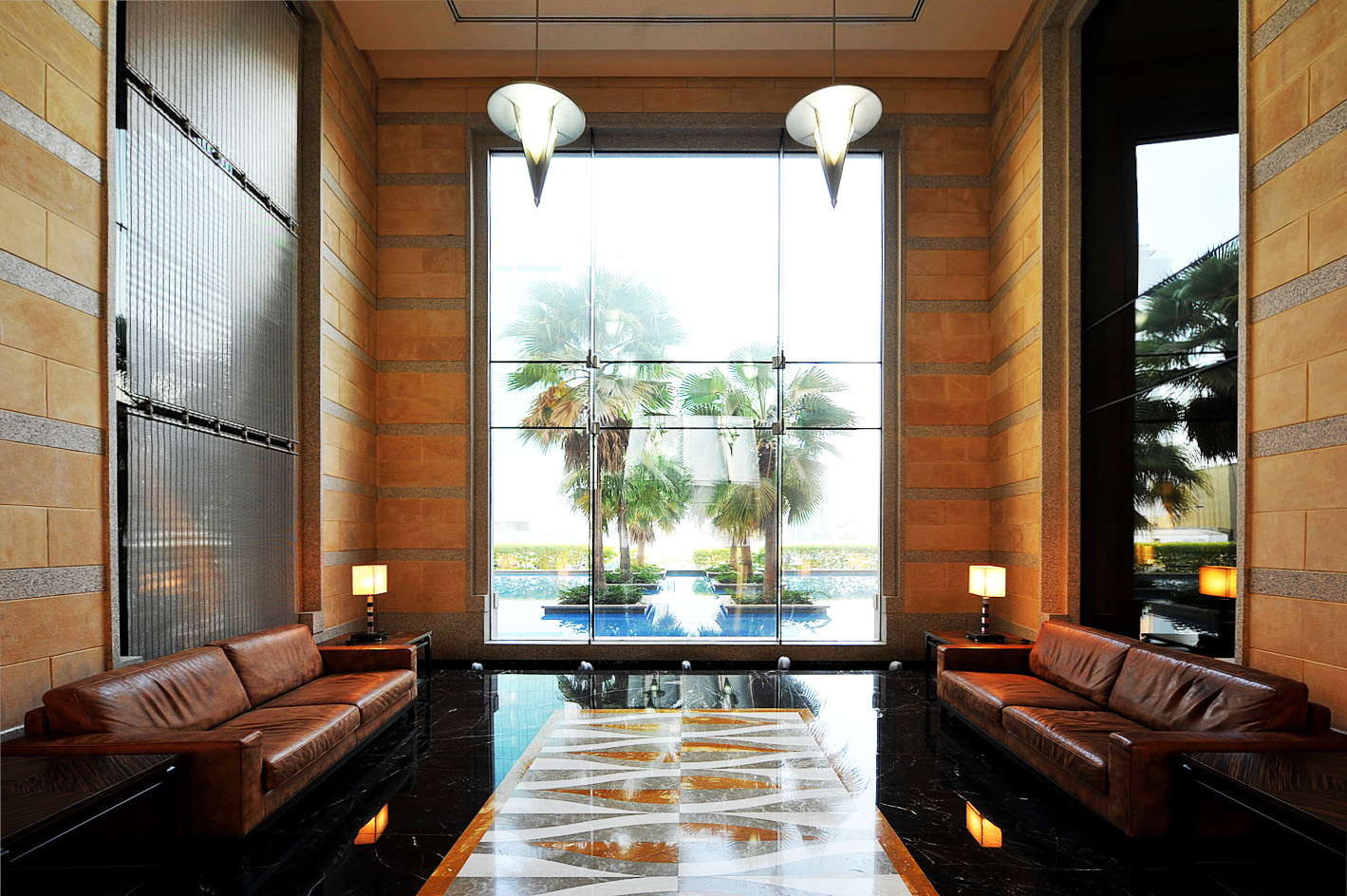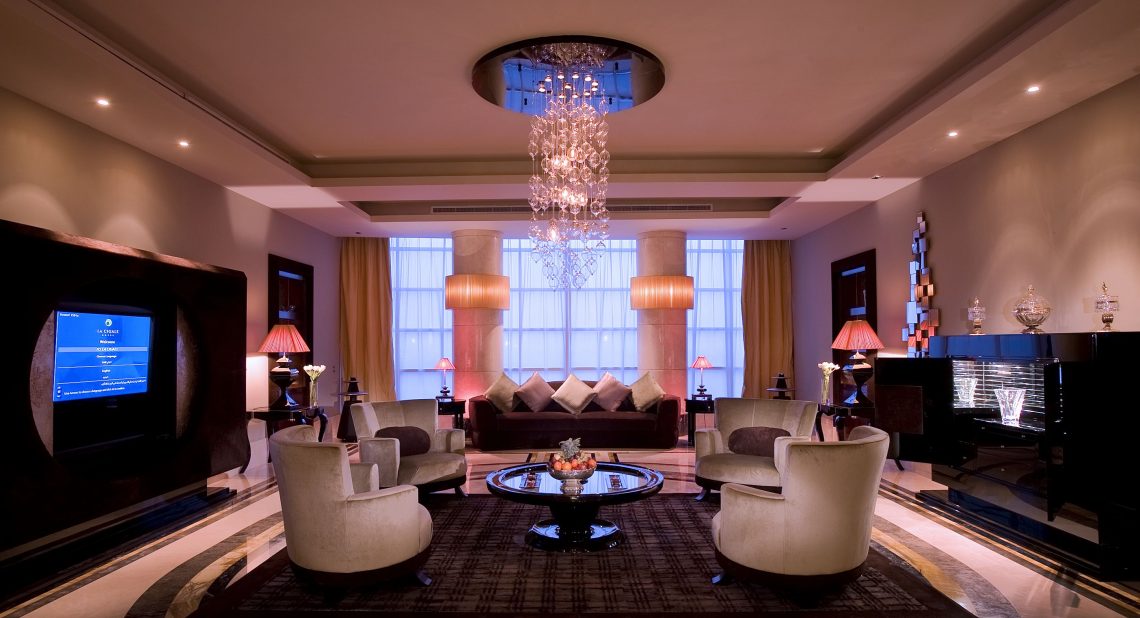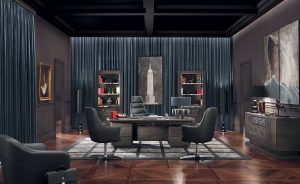The A to Z of Furnishing Luxury Hotels: a Guide
There is no accepted universal definition for the word “luxury” in the interior design sector as it can vary depending on location and on various subjective qualities. Yet, especially when it comes to hotels, one can follow certain guidelines for making every space feel luxurious.
In the following pages we will examine:
- How to furnish every space within a luxury hotel
- Furnishing the lobby of a luxury hotel
- A luxury suite for everyone
- Focus on the bathroom
- Do not undervalue the décor of the hallways
- Upscale décor
- Furniture for hallways
- A luxury spa for relaxation
- Furnishing the bar/restaurant area of a luxury hotel
- The conference room
- Ideas for furnishing the outdoor area of a luxury hotel
- Garden or pool area
- Terrace
- Veranda
- A look at innovative luxury hotels: smart décor
- Domotics in interior design
It is not just the furniture and décor that make a hotel luxurious. The level of service, the precision of the staff, and the more or less wide range of choices that a guest is offered are incredibly important. Nevertheless, the initial impression is certainly made by the way in which each environment is furnished, and the quality of the furniture and its functionality absolutely have a strong impact on a guest’s experience.
To be luxurious, a hotel must make its guests’ stay unforgettable, creating environments that are comfortable and, at the same time, aesthetically beautiful, furnished with taste and with a maniacal attention to detail. Initially one might think that a hotel has less environments than a home, but nothing could be more wrong. A wide variety of contexts exist within a hotel: not just the lobby and the rooms, but also the spa and the conference room, to name a few. All must adhere to a specific style and must be carefully furnished to obtain a luxurious end result. Let’s now take a step-by-step look at how to furnish a luxury hotel.
How to Furnish Every Space Within a Luxury Hotel
The world of hospitality is constantly evolving. More and more frequently hotels are seeking to give their guests a unique experience. How? By designing and modifying the interior and exterior spaces in order to guarantee personalised experiences, turning their stay into a true escape from reality, and at the same time providing maximum comfort with high quality furniture.
What environments should we pay particular attention to when it comes to furnishing a luxury hotel?
Certainly the lobby and the rooms, in which special attention should be given to the bathroom, but the hallways, conference rooms, restaurant, outdoor spaces, and spa (which is essential in a luxury hotel) are all very important as well. We will start, therefore, with the lobby, or reception area, of the hotel.
Furnishing the Lobby of a Luxury Hotel
The lobby of a hotel includes reception, luggage storage, a restroom, and a waiting area. It is the first thing that a guest sees when he or she walks through the door, therefore it is incredibly important and furnishing it in the style that will then be maintained throughout the entire hotel is fundamental.
First of all, we must ensure that guests are never bored, either visually or functionally. Depending on the specific style chosen, the furniture must be arranged in such a way that it does not create obstacles and must be laid out intelligently according to its intended purpose. For example, the reception desk must be easily reached as soon as the guest enters the lobby, while the armchairs and sofas must create a separate and cosy environment. If you want a classic look, opt for neutral or pastel shades that can be livened up with accessories like pillows, lamps, vases, and rugs. Do not forget to spread books and magazines out on the tables so that guests have something to keep themselves occupied.
If, on the other hand, you want to create a futuristic environment, play with the shapes and colours of the sofas and armchairs, incorporating electric blue, steel inserts, or irregular and sinuous forms. In this case you can include accessories, like paperweights or tabletop ornaments, made from high-tech or steel materials and provide specialised magazines that may interest your guests.

A Luxury Suite for Everyone
Now let’s talk about the rooms, the lifeblood of a hotel. In a luxury hotel it is actually more appropriate to talk about “suites”, as a guest expects any room that he or she selects to be unique, comfortable, and perfectly suited to his or her needs. For example, a true luxury hotel must be able to provide each guest with the room that he or she has requested, with all of the specifics of the individual situation: pet friendly, suitable for disabled persons, on the ground floor, with a sea or garden view, with a king size bed or with two single beds, etc..
There is a long list of attributes that a room must possess in order for a structure to be considered a luxury hotel. Here are some of the fundamental features that guests expect to find in a luxury hotel room:
- striking style: cohesive design, high quality furniture, and attention to detail;
- peace and quiet: no room must be near the elevator, the generators, or any other source of noise pollution;
- good ventilation and no unpleasant odours, like those of stale cigarette smoke or mildew;
- real works of art, whether paintings or photographs, never cheap reproductions or posters;
- curtains made from fabrics like linen, cotton, or silk, never from cheap materials like fibreglass cloth or acrylic, and a large window that fills the room with light;
- a bed with a high quality mattress and cotton or silk sheets, no bedspreads made form synthetic fabrics;
- a suitable amount of space for clothing, luggage and other items (table, large closet, dresser). The closet must have enough hangers and these must be either wooden or velvet;
- a comfortable reading chair, comfortable but designer, and a desk or work surface;
- a decent level of technological equipment: a safe, the latest generation of large-screen TV (no to ceiling or wall-mounted rotating screens) which could also be concealed within a piece of furniture, aux jacks, a heating system that can be easily regulated;
- the ability to interact with electronic devices (see the section dedicated to domotics);
- a full-length designer mirror.
Focus on the Bathroom
Just like the bathroom in a luxury home, the bathroom in a 5-star (or more) hotel must meet certain expectations. First of all, it must reflect the style of the rest of the room. Then, it must be clad in high quality materials (whether tiles, marble, or mosaics). Wood is also an option, but it must be maintained in perfect condition.
The bathroom in a luxury hotel must be well-ventilated, with a large window or with an excellent (and quiet) ventilation system. A large tub, a shower with easily regulated water pressure, a large mirror, and a designer piece of furniture complete the décor. And do not forget to provide guests with soft bathrobes and slippers, towels, natural bath gel and shampoo, body lotion, shower caps, toothbrushes, and toothpaste.

Do Not Undervalue the Décor of the Hallways
The hallways of a hotel are of fundamental importance and are all to often undervalued in interior design projects. In general, these “walk-through” spaces should reflect the style of the structure, yet also be functional. Here the lighting and the decorative prints play an important role. But let’s take a closer look at some methods for making even an anonymous hallway feel luxurious.
Upscale Décor
The hallway must lead guests to their room or to reception in the most linear way possible. Therefore, play with decorative motifs on the carpet or on the floor, mosaics or colours that “guide” guests towards their desired location. Remember that the wall coverings must be durable, yet also convey the style of the hotel.
The lighting must be carefully studied as well. If possible it should be natural and come from windows not covered by curtains. In the evening opt for designer spotlights and table lamps where space permits (for example in the elevator waiting area).
Furniture for Hallways
CONSOLE TABLES – Narrow enough to adapt to the space, but not so narrow that they cannot be accessorized with tabletop ornaments or designer objects. Consoles are an excellent choice for a hallway. Embellish them with a small floral composition, a decorative object, a pile of antique books, scented candles, or any other small and attractive piece of décor.
WALLS – A colourful rug or one with a graphic motif and a few chairs and sofas are enough to bring a hallway to life, but the walls are also important. An interesting idea is to collect unusual mirrors and to arrange them on a white background. These will help to create a unique, interesting, and extravagant wall that will make your hallway really stand out. Combine pieces of furniture and blend styles for an impeccable result.
NEUTRAL OR PASTEL COLOURS – Too many dark or deep colours in the hallway will make the space seem narrow and may cause guests to feel claustrophobic. Instead choose neutral or pastel colours that can be livened up with mosaics, works of art, and decorative motifs.
A Luxury Spa for Relaxation
Wellness centres and spas are among the features that guests expect to find in a luxury hotel. You can choose to decorate these spaces in various styles: classic, modern, minimalist, or country. For a classic look you can select inlaid wood furniture (chairs, small tables, cabinets), large sofas with velvet and gold details, as well as jacuzzi tubs and old style showers.
For a modern look, on the other hand, it is a good idea to make use of materials like stainless steel and glass, selecting furniture with neutral tones and geometric shapes. The tubs can be enhanced by ad hoc lighting, like LED spotlights installed underwater or at the edge of the tub, while the showers must be rectangular and spacious, constructed from materials of the latest generation. Works of art can also be incorporated in the spa, always maintaining the chosen style.
Finally wood can be used for various looks, depending on its shape and colour. For a minimalist look, dark tones like oak and ebony (teak and grey) are the right choice. Walnut and cherry wood, on the other hand are recommended if you would like to create an elegant and sophisticated space.
Furnishing the Bar/Restaurant Area of a Luxury Hotel
When one is preparing to furnish the bar and restaurant of a luxury hotel, the significance of the world “luxury” in relation to the environment in which it is situated must be stressed. For example, opulence in a space dedicated to food service is almost never synonymous with luxury. Instead, an elegant, minimalist, and sophisticated décor could be the right choice. One must always keep in mind the style of the hotel, but in this case it is important to consider something else as well: guests must find not only a luxurious environment, but also one that is extremely functional.
You must create an environment that is well-suited to a sophisticated and demanding clientele which can here enjoy food and drinks while at the same time nurturing important relationships. The spaces that will be created must, therefore, be comfortable for moments of relaxation, but also intimate for private meetings. The bar must be large and spacious, tidy, and always clean. No to plexiglass, yes to high-tech materials and wood.
In terms of the restaurant, the same rules apply. A visible kitchen, if well-organised and tended, can be a feature that makes a restaurant unique. Well-spaced tables, with tablecloths or not depending on the style, steel cutlery, and high quality décor are essential. In this environment avoid carpets and rugs. A wood or marble floor facilitates cleaning and ensures impeccable hygiene. To liven up the space, opt for paintings on the walls and play with the colours of the centrepieces or of the chairs. Always create symmetry between the three main colours (no more than that).
The Conference Room
In a luxury hotel it is important to give one’s guests the opportunity to organise conferences and meetings within the structure. To this end it is necessary to provide a spacious room, preferably with large windows, and to furnish it with particular care. As with all spaces, the meeting rooms must reflect the style of the hotel.
If you want to maintain a classic style, select a solid wood table and clad the walls (or part of them) in wood. Then opt for wall lamps and overhead fixtures, so that the room is always very well lit. Do not forget the chairs: they must be comfortable enough for guests to sit in for hours at a time. Add character to the room with prints and paintings, and make sure there is an area for water and coffee in which a well-crafted bar and table can be positioned.
For a more modern style, choose leather chairs to be matched with a dark wood or glass table. You can also create a mirror wall that reflects and radiates natural light, creating space, or maintain neutral tones that are not distracting. Add a touch of style with a particular colour or piece of exclusive furniture. For the lighting use floor lamps with a steel stem, positioned in the four corners of the room and modern ceiling fixtures, in unusual shapes, to add character.

Ideas for Furnishing the Outdoor Area of a Luxury Hotel
In a luxury hotel it is of fundamental importance to organise the external spaces, enhancing them with a well-studied design project. Depending on the type of space and on the image that the owner wants to convey, it is in fact possible to find interesting design solutions for the outdoor area. Thanks to a well-studied project and through the use of high quality, comfortable, and functional pieces of furniture, a successful result is guaranteed.
Garden and Pool Area
For luxury hotels that have a large outdoor area at their disposal, the best thing to do is to build a pool. This becomes the fulcrum of outdoor life for guests. Here they can relax during the day, dedicate themselves to self-care, or swim. (For an extra touch set up a gym space at the edge of the pool.) The area can be furnished with umbrellas or light-coloured lounge chairs (best for sun bathing) or canopies, making sure that they are comfortably spaced. In the evening the pool area can transform into a venue for banquets, parties, and events. To this end, you can add designer tables and chairs, candles, and subdued, yet present, lighting with spotlights and floor lamps. The garden can be further embellished with elegant lanterns, flowerbeds, and illuminated pathways.
Terrace
For those hotels that do not have a garden or patio, it is still possible to create an outside space on the terrace. In this case the furniture is nearly the same, with a few exceptions: umbrellas to protect from the sun, plants, small sofas, tables, and chairs, all of the elements conforming to the style of the structure in which they are placed. Remain with simple furniture in neutral tones, which can then be embellished with colourful pillows (remember the rule of the three main colours that are repeated), throw blankets (if the area is open to guests also in the winter), and luxury candles and candleholders.
Veranda
A veranda can be useful if you need an external space that can be taken advantage of year round. You can opt for a glass or wrought iron veranda, hopefully with a skyroof, that can be set up for both lunches and dinners, as well as house a lounge/bar for cocktails and relaxing moments, accompanied by soft music and a beautiful view. Select furniture like low tables and outdoor sofas and armchairs, or, if the veranda is set up to be a dining room, tables and chairs. Depending on the style of the hotel, you can incorporate specific accessories like lamps, candleholders, cushions, vases, etc.

A Look at Innovative Luxury Hotels: Smart Décor
The future of interior design, both in the home and in hotels, is domotics, which provides various advantages:
- economic, making it possible to optimise energy resources, management costs, and costs related to consumption;
- safety and control, for both the operator and the guest, who benefits from greater management autonomy;
- optimisation of work in terms of time saving for employees
- comfort and image to make a guest’s stay more comfortable, providing him or her with innovative and intriguing service.
Domotics in Interior Design
In every room it is possible to provide guests with the option of interacting with all of the room’s functions via tablet, remote control, or keypad provided by the hotel (or perhaps voice commanded virtual assistants), starting with control of the lighting, air conditioning, and audio/music system.
Domotics in lighting makes it possible, through the use of movement sensors and voice recognition, to have light only where and when necessary, with minimal effort. Also when it comes to temperature, domotics makes it possible to customise it within every single area of the hotel, maintaining the ideal climate and optimal air quality depending on the outside temperature and on the presence of people.
Thanks to the latest generation of audio-video systems, guests can also decide which music to listen to, turn the lights and the air conditioner on and off at certain times, set the alarm clock, open and close the shutters or blinds (also gradually over the course of a selected time span), and so on and so forth, with almost endless possibilities.
In fact, domotics can be applied not only to illumination, air conditioning, and audio-video systems, but also to all of the furniture in a hotel room. For example, the bathtub can be programmed to have a bath ready for a guest at a certain hour, the desk can transform into a work surface with just the touch of a button, the headrest and the seat of the couch can be raised and lowered with a quick voice command.
The Guests of a Luxury Hotel Deserve the Best
Whether you are an architect or interior designer, do not ignore any of the details we have mentioned. The important thing is to maintain consistency in the décor and in the colours so as to create a striking visual impact for the guests of your luxury hotel.
Do not overlook the functionality of the furniture, which can be “smart”, to ensure comfort and ergonomics, but also to provide outstanding service that meets every demand.







